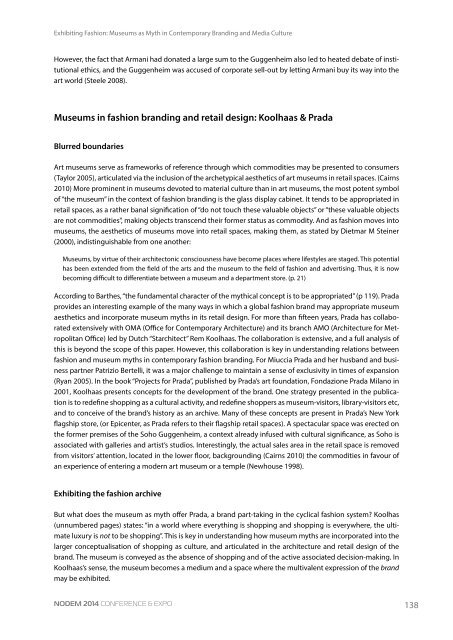NODEM 2014 Proceedings
NODEM 2014 Proceedings
NODEM 2014 Proceedings
Create successful ePaper yourself
Turn your PDF publications into a flip-book with our unique Google optimized e-Paper software.
Exhibiting Fashion: Museums as Myth in Contemporary Branding and Media Culture<br />
However, the fact that Armani had donated a large sum to the Guggenheim also led to heated debate of institutional<br />
ethics, and the Guggenheim was accused of corporate sell-out by letting Armani buy its way into the<br />
art world (Steele 2008).<br />
Museums in fashion branding and retail design: Koolhaas & Prada<br />
Blurred boundaries<br />
Art museums serve as frameworks of reference through which commodities may be presented to consumers<br />
(Taylor 2005), articulated via the inclusion of the archetypical aesthetics of art museums in retail spaces. (Cairns<br />
2010) More prominent in museums devoted to material culture than in art museums, the most potent symbol<br />
of “the museum” in the context of fashion branding is the glass display cabinet. It tends to be appropriated in<br />
retail spaces, as a rather banal signification of “do not touch these valuable objects” or “these valuable objects<br />
are not commodities”, making objects transcend their former status as commodity. And as fashion moves into<br />
museums, the aesthetics of museums move into retail spaces, making them, as stated by Dietmar M Steiner<br />
(2000), indistinguishable from one another:<br />
Museums, by virtue of their architectonic consciousness have become places where lifestyles are staged. This potential<br />
has been extended from the field of the arts and the museum to the field of fashion and advertising. Thus, it is now<br />
becoming difficult to differentiate between a museum and a department store. (p. 21)<br />
According to Barthes, “the fundamental character of the mythical concept is to be appropriated” (p 119). Prada<br />
provides an interesting example of the many ways in which a global fashion brand may appropriate museum<br />
aesthetics and incorporate museum myths in its retail design. For more than fifteen years, Prada has collaborated<br />
extensively with OMA (Office for Contemporary Architecture) and its branch AMO (Architecture for Metropolitan<br />
Office) led by Dutch “Starchitect” Rem Koolhaas. The collaboration is extensive, and a full analysis of<br />
this is beyond the scope of this paper. However, this collaboration is key in understanding relations between<br />
fashion and museum myths in contemporary fashion branding. For Miuccia Prada and her husband and business<br />
partner Patrizio Bertelli, it was a major challenge to maintain a sense of exclusivity in times of expansion<br />
(Ryan 2005). In the book “Projects for Prada”, published by Prada’s art foundation, Fondazione Prada Milano in<br />
2001, Koolhaas presents concepts for the development of the brand. One strategy presented in the publication<br />
is to redefine shopping as a cultural activity, and redefine shoppers as museum-visitors, library-visitors etc,<br />
and to conceive of the brand’s history as an archive. Many of these concepts are present in Prada’s New York<br />
flagship store, (or Epicenter, as Prada refers to their flagship retail spaces). A spectacular space was erected on<br />
the former premises of the Soho Guggenheim, a context already infused with cultural significance, as Soho is<br />
associated with galleries and artist’s studios. Interestingly, the actual sales area in the retail space is removed<br />
from visitors’ attention, located in the lower floor, backgrounding (Cairns 2010) the commodities in favour of<br />
an experience of entering a modern art museum or a temple (Newhouse 1998).<br />
Exhibiting the fashion archive<br />
But what does the museum as myth offer Prada, a brand part-taking in the cyclical fashion system? Koolhas<br />
(unnumbered pages) states: “in a world where everything is shopping and shopping is everywhere, the ultimate<br />
luxury is not to be shopping”. This is key in understanding how museum myths are incorporated into the<br />
larger conceptualisation of shopping as culture, and articulated in the architecture and retail design of the<br />
brand. The museum is conveyed as the absence of shopping and of the active associated decision-making. In<br />
Koolhaas’s sense, the museum becomes a medium and a space where the multivalent expression of the brand<br />
may be exhibited.<br />
<strong>NODEM</strong> <strong>2014</strong> Conference & Expo<br />
138


